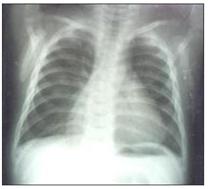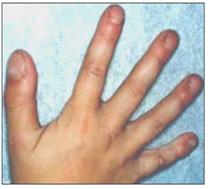객혈(각혈) Hemoptysis
- 혈액이나 혈담이 하기도-후두 기관, 기관지, 세기관이나 폐 등에서 객출하는 것을 객혈이라 한다.
- 위장관 액이나 피가 섞인 구토물이 식도, 위, 장관 등에서 객출하는 것을 토혈(Hematemesis)이라 한다.
- 소아들에게 객혈이 생기는 것을 가끔 볼 수 있다.
- 코에서 난 피나 입안이나 목안에서 난 피를 객혈로 오진할 수 있다.
- 일반적으로 객혈과 토혈을 쉽게 감별할 수 없다.
- 그러나 금방 난 붉은 피를 뱉고 피에 거품이 섞여 있으면 객혈일 가능성이 더 많다.
- 그와 반대로, 뱉은 피가 검붉거나 짙은 갈색이거나 그 핏속에 음식물 찌꺼기가 섞여 있을 때는 토혈일 가능성이 많다.
객혈의 원인

사진 12. 정상 가슴 X선 사진.
Copyright ⓒ 2011 John Sangwon Lee, MD., FAAP

사진 13. 만성 폐병이나 기관지 확장증 등으로 곤봉상지(곤봉 손가락)가 손가락끝 마디에 생길 수 있다.
Copyright ⓒ 2011 John Sangwon Lee, MD., FAAP
-
객혈의 원인은 많다.
-
소아청소년들의 객혈의 원인 중 가장 흔한 원인은 기관지염이다.
-
기관지염의 원인 중 가장 흔한 원인은 급성 바이러스 기관 기관지염이다.
-
그 다음으로 소아청소년들의 각혈의 흔한 원인은 박테리아 폐렴이나 폐결핵 등 호흡기 감염병이다.
-
객혈이 다른 여러 종류의 폐 질환으로도 생길 수 있다.
-
그 외 기관 내 이물이나
-
기관지 내 이물,
-
기관절개 기도,
-
기관 기관지 폐 선천성 기형,
-
기관 기관지 내 혈관 종,
-
가슴 타박상,
-
호흡기 외과적 진단 치료 후,
-
혈액응고 이상 등으로 객혈이 생길 수 있다.
-
폐디스토마 등 폐 기생충증, 결핵,
-
기관지 종양이나 기관지 농양,
-
폐농양이나 종양,
-
폐기종,
-
기관지 확장증,
-
전이성 폐종양,
-
기관지 선종양 등으로 객혈이 생길 수 있다1- 참조문헌.
-
그 외
객혈의 증상 징후
- 일반적으로 순수한 피가 기침할 때 소량 나오거나 가래에 섞여 피가 나오는 것이 보통이다.
- 아주 드물게 피가 폐나 기관지 등에서 대량 나올 수 있다.
- 성인의 경우는 하루에 200cc 이상 객혈하면 생명에 위혐 하다.
- 폐나 기관지에서 피가 나오지도 않고, 또는 그 외 다른 하기도에서 나오지 않는 피, 즉 진짜 객혈이 아닌 피를 객혈이라 오진할 수 있다.
- 이런 가짜 출혈이 진짜 객혈보다 사실상 더 흔하다.
- 피를 뱉기 전 구토나 구역질이 먼저 생기고 피를 뱉으면 토혈일 가능성이 더 많다.
- 토혈 속에 음식물 찌꺼기가 섞여 있을 수 있다.
- 그러나 객혈 속에 침이나 거품이 섞여 있는 경우가 더 많다.
- 토혈 하는 경우, 간이나 비장이 부었거나 복통이 있을 가능성이 더 많다.
- 객혈하는 경우, 청진기로 가슴을 진찰할 때 이상 기도 음이나 폐음이 기관이나 기관지 폐에서 날 수 있고
- 숨소리가 비정상적으로 적게 들릴 수 있고
- 드물게는 곤봉상(사진 13 참조) 손가락이 생길 수 있다.
- 이런 여러 징후 증상 진찰 소견 등에 따라 토혈과 객혈을 감별 진단한다.
- 때로는 여러 가지 임상검사를 하지 않고서 확실히 감별 진단하기가 어렵다.
객혈의 진단 치료
- 증상 징후 병력 진찰 소견 등을 종합해서 객혈이 있는 것 같으면 객담과 객혈로 그램 염색 현미경 박테리아검사, 박테리아 배양검사를 하고 하기도와 폐 등 가슴 x-선 사진, MRI 검사, 스캔 검사를 하고, 혈액 응고 스크린 검사 등을 해 그 결과를 총 종합해 진단 할 때도 있다.
- 박테리아, 곰팡이, 결핵균, 기생충 등 병원체 검사를 필요에 따라 한다.
- 필요에 따라 기관 기관지 내시경 검사로 진단할 수 있다.
- 치료는 원인에 따라서 한다.
Hemoptysis 객혈(각혈)
• Hemoptysis is the exudation of blood or bleeding from the lower respiratory tract-laryngeal organs, bronchi, bronchi or lungs.
• Hematemesis is when gastrointestinal fluid or vomit mixed with blood comes out of the esophagus, stomach, and intestines.
• It is sometimes seen that children develop hemoptysis.
• Blood from the nose or from the mouth or throat can be misdiagnosed as hemoptysis.
• In general, hemoptysis cannot be easily differentiated between hematopoiesis.
• However, if you spit out red blood and have bubbles in your blood, you are more likely to be hemoptysis.
• Conversely, if the spit blood is dark red or dark brown, or contains food debris in the blood, it is more likely to be hematopoiesis.
Causes of hemoptysis

Picture 12. Normal chest X-ray. Copyright ⓒ 2011 John Sangwon Lee, MD., FAAP

Photo 13. Chronic lung disease or bronchiectasis can cause club upper limbs (club fingers) to appear on the fingertips. Copyright ⓒ 2011 John Sangwon Lee, MD., FAAP
• There are many causes of hemoptysis.
• The most common cause of hemoptysis in children and adolescents is bronchitis.
• The most common cause of bronchitis is acute viral bronchitis.
• The next most common cause of keratinization in children and adolescents is respiratory infections such as bacterial pneumonia or pulmonary tuberculosis.
• Hemoptysis can also result from many other types of lung disease.
• Other organs • foreign bodies in the bronchi,
• tracheostomy airway,
• bronchial pulmonary congenital malformations, • hemangiomas in the bronchi, • chest bruises, • After respiratory surgical diagnostic treatment,
• Hemoptysis may occur due to abnormal blood clotting. • Pulmonary parasites such as pulmonary dystomosis, tuberculosis,
• bronchial tumor or bronchial abscess,
• lung abscess or tumor,
• emphysema,
• bronchiectasis, • metastatic lung tumor,
• Hemoptysis may occur due to bronchial adenoma, etc. 1- Reference.
• etc
Symptoms, signs of hemoptysis
• Normally, pure blood comes out when coughing, or when it is mixed with phlegm, it is common to bleed.
• Very rarely, large amounts of blood can come from the lungs or bronchi.
• In the case of adults, hemoptysis over 200cc per day is dangerous to life.
• Blood that does not come out of the lungs or bronchi, or other lower respiratory tract, that is, blood that is not genuine hemoptysis can be misdiagnosed as hemoptysis.
• This fake bleeding is virtually more common than real hemoptysis.
• Vomiting or nausea occurs first before you spit blood, and if you spit blood, you are more likely to have hematopoiesis.
• There may be food debris mixed in the hematopoietic blood.
• However, more often the hemoptysis contains saliva or foam.
• If you are vomiting, you are more likely to have swollen liver or spleen or abdominal pain.
• In the case of hemoptysis, abnormal airway or lung sounds may come from the trachea or bronchial lungs when examining the chest with a stethoscope.
• You may hear unusually low breathing
• Rarely, club scars (see photo 13) may result in fingers.
• Differentially diagnose hematopoietic and hemoptysis according to these various signs, symptoms, and examination findings. • Sometimes it is difficult to reliably diagnose differential diagnosis without performing various clinical tests.
Diagnosis, treatment of hemoptysis
• Symptoms, Signs, medical history, examination findings, etc. If it seems that there is hemoptysis, sputum and hemoptysis gram staining microscopic bacteria tests, bacterial culture tests are performed, chest x-rays such as the lower extremities and lungs, MRI tests, scan tests, and blood clotting In some cases, screen tests are performed and the results are aggregated and diagnosed.
• Test for pathogens such as bacteria, fungi, Mycobacterium tuberculosis, and parasites as necessary.
• If necessary, it can be diagnosed by bronchoscopy.
• Treatment depends on the cause.
출처 및 참조 문헌 Sources and references
- NelsonTextbook of Pediatrics 22ND Ed
- The Harriet Lane Handbook 22ND Ed
- Growth and development of the children
- Red Book 32nd Ed 2021-2024
- Neonatal Resuscitation, American Academy Pediatrics
- www.drleepediatrics.com제13권. 소아청소년 혈액, 림프, 종양 질환
- www.drleepediatrics.com제7권 소아청소년 감염병
- Red book 29th-31st edition 2021
- Nelson Text Book of Pediatrics 19th — 21st Edition
- The Johns Hopkins Hospital, The Harriet Lane Handbook, 22nd edition
-
Childhood Emergencies in the Office, Hospital and Community, American Academy of Pediatrics
-
Emergency Medical Service for Children, By Ross Lab. May 1989. p.10
-
Emergency care, Harvey grant, and Robert Murray
-
Emergency Care Transportation of Sick and Injured American Academy of Orthopaedic Surgeons
-
Emergency Pediatrics A Guide to Ambulatory Care, Roger M. Barkin, Peter Rosen
-
Immediate care of the acutely ill and injured, Hugh E. Stephenson, Jr
-
The Critically Ill Child, Diagnosis and Management, Edited by Clement A. Smith
-
Emergency Medical Services for Children: The Role of the Primary Care Provider, America Academy of Pediatrics
-
Quick Reference To Pediatric Emergencies, Delmer J. Pascoe, M.D., Moses Grossman, M.D. with 26 contributors
-
Manual of Emergency Care
-
응급환자관리 정담미디어
-
소아가정간호백과–부모도 반의사가 되어야 한다, 이상원
-
Neonatal Resuscitation American heart Association
-
Neonatology Jeffrey J.Pomerance, C. Joan Richardson
-
Pediatric Resuscitation Pediatric Clinics of North America, Stephen M. Schexnayder, M.D.
-
Pediatric Critical Care, Pediatric Clinics of North America, James P. Orlowski, M.D.
-
Preparation for Birth. Beverly Savage and Dianna Smith
- Infectious disease of children, Saul Krugman, Samuel L Katz, Ann A. Gershon, Catherine Wilfert
-
The Harriet Lane Handbook 19th Edition
-
소아과학 대한교과서
-
제1권 소아청소년 응급의료 참조문헌과 출처
-
Other
Copyright ⓒ 2015 John Sangwon Lee, MD., FAAP
“부모도 반의사가 되어야 한다”-내용은 여러분들의 의사로부터 얻은 정보와 진료를 대신할 수 없습니다.
“The information contained in this publication should not be used as a substitute for the medical care and advice of your doctor. There may be variations in treatment that your doctor may recommend based on individual facts and circumstances. “Parental education is the best medicine.”